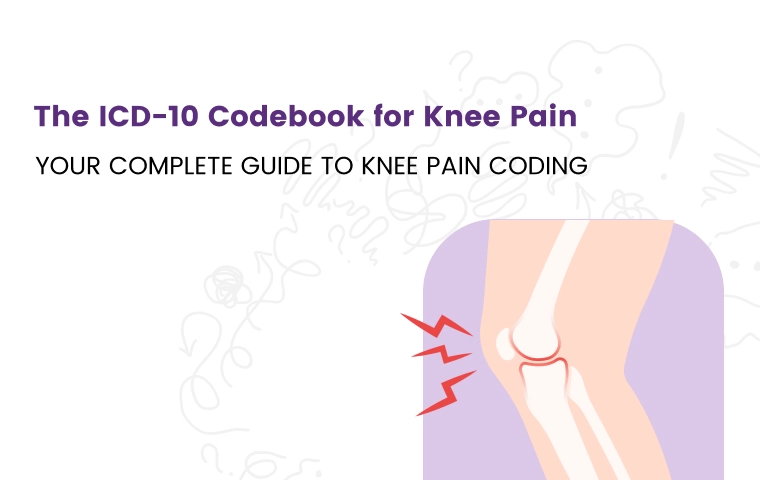Knee pain—it's a common complaint that walks through your door, but coding it correctly can be a real pain in the...well, you know. With a sea of ICD-10 codes swirling around, choosing the right one for the specific injury and treatment plan and side of the pain can be complex.
Getting it wrong isn't an option. Incorrect codes lead to claim denials, delayed payments, and a whole lot of unnecessary stress. But don't worry, we're here to untangle this web of codes and make your life easier. This comprehensive guide will break down the most essential ICD-10 codes for knee pain, offering clear explanations.
So, grab a cup of coffee, Get ready to simplify your billing process, optimize reimbursements, and say goodbye to the headache of knee pain coding
General ICD 10 Codes for Knee Pain
Using a generic ICD-10 code M25.56 for knee pain might seem like a quick fix, but it doesn’t always work. Just like knees come in pairs, so do their potential problems—and each requires a tailored approach in coding.
Think about it: is the pain in the right knee or the left? Is it chronic or acute? Is it caused by arthritis, an injury, or something else entirely? These details matter, and the ICD-10 system has specific codes to capture them all.
Ignoring these specifics not only risks inaccurate documentation but can also lead to lower reimbursement rates or claim denials. After all, why settle for a generic code when you can accurately reflect the complexity of your patient's condition?
What ICD-10 code is used for Knee Pain Unspecified
Sometimes, knee pain presents itself without a clear-cut diagnosis. The patient knows it hurts, but the exact cause remains elusive. In these cases, where the origin of the pain is unclear, the ICD-10 code M25.569 (Pain in unspecified knee) steps in to save the day.
This code is your go-to option when a definitive diagnosis hasn't been reached, but you still need to document the patient's discomfort. It acts as a placeholder, acknowledging the presence of pain while allowing for further investigation and treatment.
M25.569 can be further specified with a 7th character to indicate laterality:
-
M25.5691: Pain in right unspecified knee
-
M25.5692: Pain in left unspecified knee
Right Knee Pain ICD 10 Code
When your patient complains of pain specifically in their right knee, then icd 10 code for pain in right knee M25.561 comes into play. This code is the gold standard for pinpointing right knee pain, whether it's a dull ache, a sharp stab, or anything in between.
M25.561 is more specific than the generic M25.5 code and provides a clearer picture of the patient's condition. To ensure accurate documentation, remember to indicate the side of the pain (right in this case).

ICD 10 Code for Pain In Left Knee
When your patient's discomfort is localized to their left side, ICD-10 code M25.562 is your trusty companion. It's the mirror image of the right knee pain code we discussed earlier, providing that all-important specificity that billers and coders crave.

What ICD 10 Codes are Used For Acute & Chronic Knee Pain?
There are no specific codes that can be used as ICD 10 codes for Acute Knee Pain and Chronic Knee Pain
The appropriate code depends on the underlying cause and specific characteristics of the pain. Here's how to approach coding acute knee pain:
1. Determine the Cause:
-
Injury: If the pain is due to a recent injury (e.g., sprain, strain, fracture), look for codes in the injury section of the ICD-10-CM manual (S80-S89).
-
Underlying Condition: If the pain is a symptom of a known condition like osteoarthritis (M17.-), rheumatoid arthritis (M05-M08), or gout (M10.-), use the code specific to that condition.
-
Unknown Cause: If the cause is unclear or unspecified, you can use the general code for knee pain, M25.56.
2. Specify Laterality:
-
Once you've identified the appropriate code, add a 7th character to indicate whether the pain is in the right knee (1), left knee (2), or unspecified (9).
-
Example: M25.561 for acute pain in the right knee.
3. Consider the 7th Character for the Episode of Care:
-
You may need to add another 7th character to specify whether it's the initial encounter (A), subsequent encounter (D), or sequela (S).
-
Example: S83.51xA for a sprain of the cruciate ligament of the right knee, initial encounter.
Final Words
There you have it – your guide to the sometimes complex world of ICD-10 coding for knee pain. Remember, accurate coding is about more than just choosing a number. It's about capturing the unique details of each patient's condition to ensure proper documentation, streamline billing, and, ultimately, improve patient care.
By applying the knowledge you've gained here, you can confidently choose the right codes, avoid claim denials, and maximize reimbursement. Now, armed with this information, you're well-equipped to tackle those knee pain claims with precision and ease!
ABOUT AUTHOR

John Wick
As a blog writer with years of experience in the healthcare industry, I have got what it takes to write well-researched content that adds value for the audience. I am a curious individual by nature, driven by passion and I translate that into my writings. I aspire to be among the leading content writers in the world.
